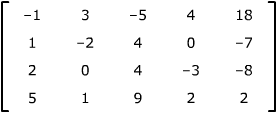
The dependency algorithm is a very useful method for figuring out the dependence relations for a given set of vectors in Rn.
| The Dependency Algorithm |
| Given vectors v1, v2, ..., vk in Rn: |
|
|
|
Here's an example. Suppose you are given five vectors in R4:
v1 = (–1, 1, 2, 5),
v2 = (3, –2, 0, 1),
v3 = (–5, 4, 4, 9),
v4 = (4, 0, –3, 2),
v5 = (18, –7, –8, 2).
Stack them into the columns of a matrix:
Reduce the matrix to reduced row-echelon form:
Then:
(Notice that you may get a different choice of independent vectors if you arrange the V's in a different order. The algorithm "chooses" independent vectors from the set starting with the left-most vector and adding vectors to its right, as long as they're not linearly dependent on the ones already chosen.)
Why the dependency algorithm works. Suppose we have vectors v1, v2, ..., vk in Rn. To determine if they are linearly independent or not, we look for the solutions c1, c2, ..., ck of the linear dependence equation
c1v1 + c2v2 + ... + ckvk = 0 .
Think of the vectors v1, v2, ..., vk as column matrices; then the left-hand side of this relation is a linear combination of columns. Write it in contracted form:
.
This is a linear system in c1, c2, ..., ck. To find c1, c2, ..., ck, we look at its augmented matrix
and reduce it to reduced row-echelon form
.
Now work in the other direction: the linear system with this augmented matrix is
.
If we write the left-hand side in expanded form, we get
c1r1 + c2r2 + ... + ckrk = 0.
Let's summarize here before going further. The two main points:
Now:
The columns of the reduced matrix with leading 1's are elementary columns, and so are linearly independent – there is no non-trivial solution of c1r1 + c2r2 + ... + ckrk = 0 involving only these columns (i.e. with the other coefficients zero). Then there is no non-trivial solution of c1v1 + c2v2 + ... + ckvk = 0 involving only the corresponding columns of the original matrix, so those columns must be linearly independent.
Every column of the reduced matrix not containing a leading 1 can be written as a linear combination of the elementary columns which precede it using the numbers in that column as coefficients. The relation that expresses it as a linear combination of those elementary columns is a solution of c1r1 + c2r2 + ... + ckrk = 0, which thus translates back into the same relation between the corresponding columns of the original matrix.